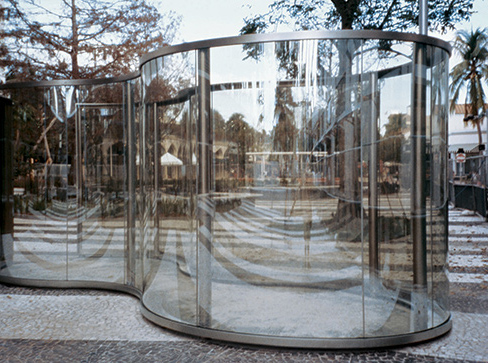
Regen Projects II 9016 Santa Monica Boulevard CA 9006 Los Angeles États-Unis
Regen Projects is pleased to present an exhibition of works by Dan Graham. Graham's multidisciplinary practice consists of writing, film, video, performance, photography, architectural models, installations, and glass and mirror structures. Using interlocking ideas of humor, inter-subjectivity, and perception Graham challenges the constantly shifting relationship of the viewer to the work. Exploring the boundaries of physical and social spaces, Graham shows the various apparatuses of how we see in relation to the nature of art and social experience. The exhibition will feature a large pavilion, models, video works, and photographs.
Graham's large-scale, quasi-functional pavilions investigate the double functions of inside and outside and experiment with ways in which opposing forces interact. Working with two-way glass and mirror, the materials of corporate office buildings built in the eighties, Graham sets up situations that embody the contradictions of public and private, interior and exterior, of reflection and projection. The two-way window materials superimpose faces and bodies, transparent gazes push the physical sensations of reflection and transparency, while the duality of the observer and the observed lies at the core of his investigation. Graham's pavilion to be exhibited at Regen Projects is a sweeping, curvaceous sculpture that works with architecture and the transmission of light in the gallery space. In addition to the pavilion, there will be five architectural models on view varying in form and complexity.
Two films will also be on view, "Death By Chocolate" and "Classic and Recent Pavilions," as well a series of photographs of New Jersey. These images were taken on a recent trip, revisiting a familiar subject matter for Graham, first seen in his early project "Homes for America." These new photographs examine lesser-known topography along the seashore and in small towns.
In many ways, Graham's work parallels the development of modern architecture. If early twentieth-century architecture was inseparable from illustrated journals, photography, and cinema, postwar architecture is inseparable from video and television. Similarly, all of Graham's work is "media-architecture," from the very first works for magazines including Homes for America (1966-67), to the house designs including Alteration, to the pavilions that currently dominate his work. It is not simply that he deals with architectural subjects--the tract house, the picture window, the corporate office building-- or that he uses media traditionally deployed by architects, but that he understands the building itself as media. From journals, to models with mirrors and glass façades, to videos in installations, to pavilions without video, we end up in his pavilions with spaces defined only by reflections, mirrors, glass, windows. The seemingly static pavilions themselves fully communicate the active space of the electronic media without the need of cameras or screens. (Beatriz Colomina. "Beyond Pavilions: Architecture as a Means to See" in Dan Graham: Beyond., published by MIT Press, Massachusetts, p. 203.)

